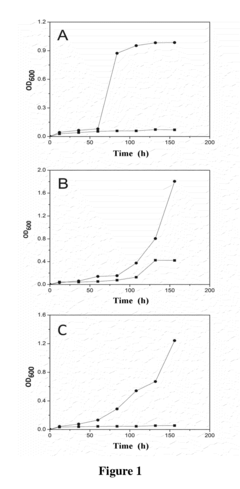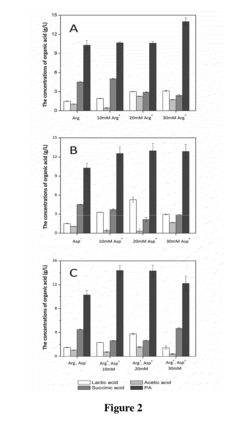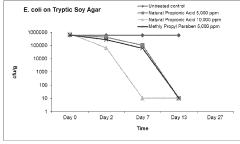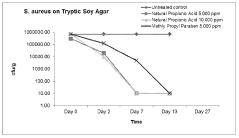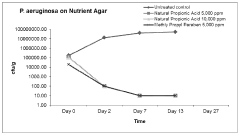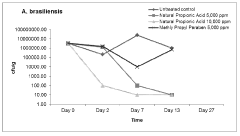Impacts of Propionic Acid on Microbial Growth Control
JUL 3, 20259 MIN READ
Generate Your Research Report Instantly with AI Agent
Patsnap Eureka helps you evaluate technical feasibility & market potential.
Propionic Acid Background and Objectives
Propionic acid, a short-chain fatty acid, has been a subject of increasing interest in the field of microbial growth control. This organic compound, naturally occurring in various foods and produced as a metabolic byproduct by certain bacteria, has demonstrated significant potential in inhibiting the growth of a wide range of microorganisms. The historical development of propionic acid as an antimicrobial agent can be traced back to its discovery in the late 19th century, with its applications in food preservation becoming more prevalent in the mid-20th century.
The evolution of propionic acid research has been driven by the growing demand for natural and effective preservatives in the food industry, as well as the need for alternative growth control methods in various biotechnological processes. Over the years, scientific understanding of propionic acid's mechanisms of action has deepened, revealing its multifaceted approach to microbial inhibition. This includes its ability to lower pH, disrupt cell membranes, and interfere with essential metabolic processes within microbial cells.
Recent technological advancements have further expanded the potential applications of propionic acid beyond traditional food preservation. Its use in animal feed, pharmaceuticals, and even as a building block for various chemical syntheses has sparked renewed interest in optimizing its production and enhancing its antimicrobial efficacy. The global market for propionic acid has shown steady growth, reflecting its increasing importance in various industries.
The primary objective of current research in this field is to comprehensively understand the impacts of propionic acid on microbial growth control across different microbial species and environmental conditions. This includes elucidating the molecular mechanisms underlying its antimicrobial activity, exploring synergistic effects with other compounds, and developing novel formulations to enhance its efficacy and stability.
Furthermore, there is a growing focus on sustainable production methods for propionic acid, including biotechnological approaches using microbial fermentation. This aligns with the broader trend towards eco-friendly and bio-based solutions in industrial processes. Additionally, researchers aim to address challenges such as the potential development of microbial resistance to propionic acid and its organoleptic impact on food products.
As we look towards the future, the trajectory of propionic acid research is likely to intersect with emerging fields such as nanotechnology and targeted delivery systems. These intersections may lead to innovative applications in precision microbial control, potentially revolutionizing food safety practices and bioprocess technologies. The ongoing exploration of propionic acid's impacts on microbial growth control continues to unveil new possibilities, promising significant advancements in antimicrobial strategies across multiple sectors.
The evolution of propionic acid research has been driven by the growing demand for natural and effective preservatives in the food industry, as well as the need for alternative growth control methods in various biotechnological processes. Over the years, scientific understanding of propionic acid's mechanisms of action has deepened, revealing its multifaceted approach to microbial inhibition. This includes its ability to lower pH, disrupt cell membranes, and interfere with essential metabolic processes within microbial cells.
Recent technological advancements have further expanded the potential applications of propionic acid beyond traditional food preservation. Its use in animal feed, pharmaceuticals, and even as a building block for various chemical syntheses has sparked renewed interest in optimizing its production and enhancing its antimicrobial efficacy. The global market for propionic acid has shown steady growth, reflecting its increasing importance in various industries.
The primary objective of current research in this field is to comprehensively understand the impacts of propionic acid on microbial growth control across different microbial species and environmental conditions. This includes elucidating the molecular mechanisms underlying its antimicrobial activity, exploring synergistic effects with other compounds, and developing novel formulations to enhance its efficacy and stability.
Furthermore, there is a growing focus on sustainable production methods for propionic acid, including biotechnological approaches using microbial fermentation. This aligns with the broader trend towards eco-friendly and bio-based solutions in industrial processes. Additionally, researchers aim to address challenges such as the potential development of microbial resistance to propionic acid and its organoleptic impact on food products.
As we look towards the future, the trajectory of propionic acid research is likely to intersect with emerging fields such as nanotechnology and targeted delivery systems. These intersections may lead to innovative applications in precision microbial control, potentially revolutionizing food safety practices and bioprocess technologies. The ongoing exploration of propionic acid's impacts on microbial growth control continues to unveil new possibilities, promising significant advancements in antimicrobial strategies across multiple sectors.
Market Analysis for Microbial Growth Control
The market for microbial growth control solutions, particularly those utilizing propionic acid, has shown significant expansion in recent years. This growth is primarily driven by increasing concerns over food safety, rising demand for natural preservatives, and the need for extended shelf life in various food products. The global food preservatives market, which includes propionic acid-based solutions, is projected to reach a substantial value in the coming years, with a steady compound annual growth rate.
Propionic acid's effectiveness in controlling microbial growth has positioned it as a key player in several industries, including food and feed preservation, pharmaceuticals, and agriculture. In the food industry, propionic acid and its salts are widely used as preservatives in baked goods, dairy products, and processed meats. The increasing consumer preference for clean-label products and natural preservatives has further boosted the demand for propionic acid-based solutions.
The animal feed sector represents another significant market for propionic acid, where it is used to prevent mold growth in animal feed and silage. With the global livestock industry expanding to meet the growing demand for meat and dairy products, the market for feed preservatives, including propionic acid, is expected to witness substantial growth.
Geographically, North America and Europe currently dominate the propionic acid market for microbial growth control applications. However, the Asia-Pacific region is emerging as a lucrative market, driven by rapid industrialization, changing dietary habits, and increasing awareness about food safety. Countries like China and India are expected to be key growth drivers in this region.
The market is characterized by the presence of several major players, including global chemical companies and specialized preservative manufacturers. These companies are investing heavily in research and development to enhance the efficacy of propionic acid-based solutions and explore new applications. Additionally, there is a growing trend towards the development of synergistic preservative systems that combine propionic acid with other natural antimicrobials to achieve broader spectrum protection against various microorganisms.
Regulatory factors play a crucial role in shaping the market dynamics. Stringent food safety regulations in developed countries and increasing regulatory harmonization in developing nations are expected to drive the adoption of effective microbial growth control solutions, including those based on propionic acid. However, the market also faces challenges, such as the growing consumer demand for minimally processed foods and the emergence of alternative preservation technologies.
Propionic acid's effectiveness in controlling microbial growth has positioned it as a key player in several industries, including food and feed preservation, pharmaceuticals, and agriculture. In the food industry, propionic acid and its salts are widely used as preservatives in baked goods, dairy products, and processed meats. The increasing consumer preference for clean-label products and natural preservatives has further boosted the demand for propionic acid-based solutions.
The animal feed sector represents another significant market for propionic acid, where it is used to prevent mold growth in animal feed and silage. With the global livestock industry expanding to meet the growing demand for meat and dairy products, the market for feed preservatives, including propionic acid, is expected to witness substantial growth.
Geographically, North America and Europe currently dominate the propionic acid market for microbial growth control applications. However, the Asia-Pacific region is emerging as a lucrative market, driven by rapid industrialization, changing dietary habits, and increasing awareness about food safety. Countries like China and India are expected to be key growth drivers in this region.
The market is characterized by the presence of several major players, including global chemical companies and specialized preservative manufacturers. These companies are investing heavily in research and development to enhance the efficacy of propionic acid-based solutions and explore new applications. Additionally, there is a growing trend towards the development of synergistic preservative systems that combine propionic acid with other natural antimicrobials to achieve broader spectrum protection against various microorganisms.
Regulatory factors play a crucial role in shaping the market dynamics. Stringent food safety regulations in developed countries and increasing regulatory harmonization in developing nations are expected to drive the adoption of effective microbial growth control solutions, including those based on propionic acid. However, the market also faces challenges, such as the growing consumer demand for minimally processed foods and the emergence of alternative preservation technologies.
Current Challenges in Antimicrobial Preservation
The field of antimicrobial preservation faces several significant challenges in the current landscape. One of the primary issues is the increasing resistance of microorganisms to traditional preservatives. This phenomenon has led to a reduced efficacy of many commonly used antimicrobial agents, necessitating higher concentrations or combinations of preservatives to achieve the desired level of microbial control.
Another challenge is the growing consumer demand for "clean label" products, which has put pressure on manufacturers to reduce or eliminate synthetic preservatives. This trend has created a need for natural alternatives that can provide equivalent antimicrobial efficacy while meeting consumer expectations for ingredient transparency and naturalness.
Regulatory constraints pose an additional hurdle in antimicrobial preservation. Different regions and countries have varying regulations regarding the use of preservatives, making it difficult for global companies to formulate products that comply with diverse regulatory requirements. Moreover, the process of approving new preservatives or expanding the use of existing ones is often lengthy and costly, limiting innovation in this field.
The complexity of modern product formulations also presents challenges for effective preservation. Many products now contain a wide array of ingredients, some of which may interact with preservatives or provide conditions favorable for microbial growth. This complexity requires a more sophisticated approach to preservation systems, often involving synergistic combinations of multiple preservatives.
Environmental concerns and sustainability issues are becoming increasingly important in the context of antimicrobial preservation. There is growing pressure to develop preservatives that are biodegradable and have minimal environmental impact. This challenge is particularly acute in industries such as personal care and household products, where preservatives may end up in wastewater streams.
The emergence of new pathogens and the evolution of existing microorganisms pose ongoing challenges to antimicrobial preservation. As microbial populations adapt and change, preservative systems must be continually evaluated and updated to ensure their effectiveness against a broad spectrum of potential contaminants.
Lastly, there is a significant challenge in balancing the need for effective preservation with product quality and sensory attributes. Some preservatives can negatively impact the taste, odor, or texture of products, particularly at higher concentrations. Finding preservative solutions that maintain product integrity while providing adequate antimicrobial protection remains a key focus for researchers and formulators in various industries.
Another challenge is the growing consumer demand for "clean label" products, which has put pressure on manufacturers to reduce or eliminate synthetic preservatives. This trend has created a need for natural alternatives that can provide equivalent antimicrobial efficacy while meeting consumer expectations for ingredient transparency and naturalness.
Regulatory constraints pose an additional hurdle in antimicrobial preservation. Different regions and countries have varying regulations regarding the use of preservatives, making it difficult for global companies to formulate products that comply with diverse regulatory requirements. Moreover, the process of approving new preservatives or expanding the use of existing ones is often lengthy and costly, limiting innovation in this field.
The complexity of modern product formulations also presents challenges for effective preservation. Many products now contain a wide array of ingredients, some of which may interact with preservatives or provide conditions favorable for microbial growth. This complexity requires a more sophisticated approach to preservation systems, often involving synergistic combinations of multiple preservatives.
Environmental concerns and sustainability issues are becoming increasingly important in the context of antimicrobial preservation. There is growing pressure to develop preservatives that are biodegradable and have minimal environmental impact. This challenge is particularly acute in industries such as personal care and household products, where preservatives may end up in wastewater streams.
The emergence of new pathogens and the evolution of existing microorganisms pose ongoing challenges to antimicrobial preservation. As microbial populations adapt and change, preservative systems must be continually evaluated and updated to ensure their effectiveness against a broad spectrum of potential contaminants.
Lastly, there is a significant challenge in balancing the need for effective preservation with product quality and sensory attributes. Some preservatives can negatively impact the taste, odor, or texture of products, particularly at higher concentrations. Finding preservative solutions that maintain product integrity while providing adequate antimicrobial protection remains a key focus for researchers and formulators in various industries.
Existing Propionic Acid-based Solutions
01 Antimicrobial properties of propionic acid
Propionic acid exhibits antimicrobial properties that can inhibit the growth of various microorganisms. It is effective against bacteria, fungi, and molds, making it useful in food preservation and agricultural applications. The acid's ability to lower pH and disrupt cellular functions contributes to its antimicrobial efficacy.- Antimicrobial properties of propionic acid: Propionic acid exhibits strong antimicrobial properties, effectively inhibiting the growth of various microorganisms, including bacteria, yeasts, and molds. This makes it a valuable compound in food preservation, animal feed, and pharmaceutical applications. The antimicrobial action of propionic acid is attributed to its ability to lower pH and disrupt cellular functions of microorganisms.
- Production of propionic acid through microbial fermentation: Propionic acid can be produced through microbial fermentation processes using various bacterial strains, particularly Propionibacterium species. This biotechnological approach offers a sustainable alternative to chemical synthesis. The fermentation process involves optimizing culture conditions, substrate utilization, and downstream processing to enhance propionic acid yield and purity.
- Use of propionic acid in animal feed preservation: Propionic acid is widely used as a preservative in animal feed to prevent microbial growth and spoilage. It helps maintain feed quality, extend shelf life, and improve animal health by inhibiting the growth of harmful microorganisms. The application of propionic acid in feed preservation is particularly important in the livestock and poultry industries.
- Synergistic effects of propionic acid with other compounds: Combining propionic acid with other antimicrobial compounds or organic acids can result in synergistic effects, enhancing overall antimicrobial activity. These combinations can provide broader spectrum protection against various microorganisms and may allow for reduced dosages of individual components. Such synergistic formulations find applications in food preservation, cosmetics, and agricultural products.
- Propionic acid derivatives and their antimicrobial applications: Various derivatives of propionic acid, such as propionates and esters, have been developed to enhance antimicrobial efficacy or modify physicochemical properties. These derivatives may offer improved stability, solubility, or targeted antimicrobial activity compared to propionic acid itself. They find applications in diverse fields, including food preservation, personal care products, and industrial antimicrobial treatments.
02 Propionic acid production through microbial fermentation
Microorganisms, particularly Propionibacterium species, can be used to produce propionic acid through fermentation processes. This biotechnological approach involves optimizing growth conditions, substrate utilization, and metabolic pathways to enhance propionic acid yield. Genetic engineering techniques may be employed to improve microbial strains for increased production efficiency.Expand Specific Solutions03 Use of propionic acid in animal feed preservation
Propionic acid is widely used as a preservative in animal feed to prevent microbial growth and spoilage. It helps maintain feed quality, extend shelf life, and reduce the risk of mycotoxin contamination. The acid can be applied directly or in the form of propionate salts, providing protection against various fungi and bacteria in stored feed materials.Expand Specific Solutions04 Synergistic effects of propionic acid with other compounds
Combining propionic acid with other antimicrobial agents or organic acids can result in synergistic effects against microbial growth. These combinations may enhance the overall antimicrobial activity, broaden the spectrum of action, or allow for lower concentrations of individual components. Such synergistic approaches are valuable in food preservation and agricultural applications.Expand Specific Solutions05 Propionic acid derivatives for microbial control
Various derivatives of propionic acid, such as esters, salts, or modified forms, can be synthesized and utilized for microbial growth control. These derivatives may offer advantages such as improved stability, targeted delivery, or enhanced antimicrobial activity compared to the parent compound. They find applications in pharmaceuticals, cosmetics, and industrial processes where microbial control is crucial.Expand Specific Solutions
Key Players in Propionic Acid Industry
The competitive landscape for "Impacts of Propionic Acid on Microbial Growth Control" is characterized by a diverse mix of academic institutions and industry players, indicating a field in the early to mid-stages of development. The market size is potentially significant, given the broad applications of microbial growth control in food preservation, agriculture, and healthcare. Key players include universities like Jiangnan University and Tianjin University, research institutions such as the Institute of Microbiology, Chinese Academy of Sciences, and companies like Kemin Industries and Meiji Co., Ltd. The involvement of both academic and industrial entities suggests ongoing research and development efforts, with varying levels of technological maturity across different applications of propionic acid in microbial control.
Jiangnan University
Technical Solution: Jiangnan University has developed a novel approach to utilizing propionic acid for microbial growth control. Their research focuses on the synergistic effects of propionic acid with other organic acids and natural antimicrobials. They have demonstrated that a combination of propionic acid with lactic acid and essential oils can effectively inhibit the growth of various foodborne pathogens, including Listeria monocytogenes and Escherichia coli O157:H7 [1][3]. The university has also explored the use of propionic acid in modified atmosphere packaging systems, showing enhanced antimicrobial activity against spoilage microorganisms in perishable foods [2]. Additionally, they have investigated the molecular mechanisms of propionic acid's antimicrobial action, revealing its ability to disrupt cell membrane integrity and interfere with cellular metabolism in target microorganisms [4].
Strengths: Comprehensive research on synergistic effects with other compounds; innovative application in food packaging systems. Weaknesses: Potential cost implications of combined antimicrobial systems; may require further studies on long-term effects on food quality.
Institute of Process Engineering, Chinese Academy of Sciences
Technical Solution: The Institute of Process Engineering has developed an advanced propionic acid-based microbial control system for industrial applications. Their approach involves the use of propionic acid in combination with engineered nanoparticles to enhance its antimicrobial efficacy [1]. This novel formulation allows for controlled release of propionic acid, prolonging its active period and reducing the overall amount needed for effective microbial control [2]. The institute has also explored the use of propionic acid in biofilm prevention, demonstrating its ability to inhibit biofilm formation in industrial water systems and food processing equipment [3]. Furthermore, they have developed a green synthesis method for propionic acid production using renewable resources, making the process more sustainable and cost-effective for large-scale applications [4].
Strengths: Innovative nanoparticle-based delivery system; effective biofilm prevention; sustainable production method. Weaknesses: Potential regulatory challenges for nanoparticle use in certain industries; may require specialized equipment for implementation.
Innovative Propionic Acid Formulations
Method for Improving Acid tolerance of Propionibacterium acdipropionici
PatentInactiveUS20140178952A1
Innovation
- Adding arginine and/or aspartic acid to the culture medium during the cultivation of Propionibacterium acdipropionici to enhance acid tolerance and propionic acid productivity.
Use of propionic acid as an antimicrobial
PatentWO2012142077A2
Innovation
- A composition containing propionic acid or its salts, derived from soy glycerin fermentation, is added to personal care products, effectively killing all five USP51 target microorganisms, including Candida albicans, Aspergillus niger, Escherichia coli, Pseudomonas aeruginosa, and Staphylococcus aureus within 7 days, with optional synergistic use of carnosic acid for reduced concentrations.
Regulatory Framework for Food Preservatives
The regulatory framework for food preservatives plays a crucial role in ensuring food safety and quality while protecting consumer health. In the context of propionic acid's impact on microbial growth control, various regulatory bodies worldwide have established guidelines and standards for its use in food products.
The United States Food and Drug Administration (FDA) recognizes propionic acid as Generally Recognized as Safe (GRAS) for use as a food preservative. The FDA has set specific limits for propionic acid usage in different food categories, such as baked goods, cheeses, and processed meats. These limits are designed to maintain effective antimicrobial activity while ensuring consumer safety.
In the European Union, the European Food Safety Authority (EFSA) has evaluated propionic acid and its salts for use as food additives. The EFSA has established an Acceptable Daily Intake (ADI) for propionic acid and its salts, which guides manufacturers on safe usage levels. The EU regulation EC 1333/2008 provides a comprehensive list of permitted food additives, including propionic acid, and specifies maximum levels for various food categories.
The Codex Alimentarius Commission, established by the Food and Agriculture Organization (FAO) and the World Health Organization (WHO), provides international food standards that serve as a reference for many countries. The Codex General Standard for Food Additives (GSFA) includes provisions for propionic acid use in various food categories, helping to harmonize regulations across different regions.
In Canada, Health Canada regulates the use of food additives, including propionic acid, through the Food and Drug Regulations. The regulations specify permitted uses and maximum levels for propionic acid in different food products, ensuring its safe application as a preservative.
Many other countries have their own regulatory frameworks for food preservatives, often based on or influenced by international standards. For instance, Australia and New Zealand have a joint food standards code that regulates the use of propionic acid in food products, while Japan's Ministry of Health, Labour and Welfare sets its own standards for food additives.
Regulatory bodies also require manufacturers to follow Good Manufacturing Practices (GMP) when using propionic acid as a preservative. This ensures that the additive is used at levels no higher than necessary to achieve the intended antimicrobial effect, further safeguarding consumer health.
As research on the impacts of propionic acid on microbial growth control continues to evolve, regulatory frameworks are periodically reviewed and updated. This ongoing process ensures that regulations remain current with the latest scientific evidence, balancing the need for effective food preservation with consumer safety concerns.
The United States Food and Drug Administration (FDA) recognizes propionic acid as Generally Recognized as Safe (GRAS) for use as a food preservative. The FDA has set specific limits for propionic acid usage in different food categories, such as baked goods, cheeses, and processed meats. These limits are designed to maintain effective antimicrobial activity while ensuring consumer safety.
In the European Union, the European Food Safety Authority (EFSA) has evaluated propionic acid and its salts for use as food additives. The EFSA has established an Acceptable Daily Intake (ADI) for propionic acid and its salts, which guides manufacturers on safe usage levels. The EU regulation EC 1333/2008 provides a comprehensive list of permitted food additives, including propionic acid, and specifies maximum levels for various food categories.
The Codex Alimentarius Commission, established by the Food and Agriculture Organization (FAO) and the World Health Organization (WHO), provides international food standards that serve as a reference for many countries. The Codex General Standard for Food Additives (GSFA) includes provisions for propionic acid use in various food categories, helping to harmonize regulations across different regions.
In Canada, Health Canada regulates the use of food additives, including propionic acid, through the Food and Drug Regulations. The regulations specify permitted uses and maximum levels for propionic acid in different food products, ensuring its safe application as a preservative.
Many other countries have their own regulatory frameworks for food preservatives, often based on or influenced by international standards. For instance, Australia and New Zealand have a joint food standards code that regulates the use of propionic acid in food products, while Japan's Ministry of Health, Labour and Welfare sets its own standards for food additives.
Regulatory bodies also require manufacturers to follow Good Manufacturing Practices (GMP) when using propionic acid as a preservative. This ensures that the additive is used at levels no higher than necessary to achieve the intended antimicrobial effect, further safeguarding consumer health.
As research on the impacts of propionic acid on microbial growth control continues to evolve, regulatory frameworks are periodically reviewed and updated. This ongoing process ensures that regulations remain current with the latest scientific evidence, balancing the need for effective food preservation with consumer safety concerns.
Environmental Impact of Propionic Acid Use
The use of propionic acid for microbial growth control has significant environmental implications that warrant careful consideration. As a widely used preservative in food and feed industries, propionic acid's environmental impact extends beyond its immediate application areas.
In aquatic ecosystems, the introduction of propionic acid can lead to changes in pH levels, potentially affecting the delicate balance of aquatic life. While propionic acid is biodegradable, high concentrations in water bodies can temporarily disrupt microbial communities and alter nutrient cycles. However, its relatively rapid degradation in natural environments mitigates long-term ecological risks.
Soil ecosystems may also be impacted by propionic acid use, particularly in agricultural settings where it is applied as a feed preservative. When propionic acid-treated feed or manure enters the soil, it can influence soil microbial populations. This effect is generally short-lived due to the acid's biodegradability, but repeated applications may lead to shifts in soil microbial community structures over time.
The production of propionic acid itself carries environmental considerations. Traditional petrochemical-based production methods contribute to carbon emissions and resource depletion. However, the emergence of bio-based production techniques, utilizing renewable resources and fermentation processes, offers a more sustainable alternative with a reduced carbon footprint.
From an air quality perspective, propionic acid has a low vapor pressure, limiting its contribution to atmospheric pollution. Nevertheless, industrial-scale use and production may result in localized emissions that require proper management to minimize environmental impact.
The use of propionic acid in livestock feed has indirect environmental benefits by reducing feed spoilage and improving feed efficiency. This can lead to decreased waste generation and potentially lower greenhouse gas emissions from livestock production. However, these benefits must be balanced against the environmental costs of propionic acid production and distribution.
In terms of waste management, propionic acid's biodegradability is advantageous. It does not persist in the environment or accumulate in food chains, reducing long-term ecological risks. However, proper disposal practices are still crucial to prevent localized environmental stress, particularly in aquatic systems sensitive to pH changes.
Overall, while propionic acid presents some environmental challenges, its biodegradability and effective microbial control properties offer a favorable balance when used responsibly. Continued research into more sustainable production methods and optimized application strategies will be key to further minimizing its environmental footprint while maximizing its benefits in microbial growth control.
In aquatic ecosystems, the introduction of propionic acid can lead to changes in pH levels, potentially affecting the delicate balance of aquatic life. While propionic acid is biodegradable, high concentrations in water bodies can temporarily disrupt microbial communities and alter nutrient cycles. However, its relatively rapid degradation in natural environments mitigates long-term ecological risks.
Soil ecosystems may also be impacted by propionic acid use, particularly in agricultural settings where it is applied as a feed preservative. When propionic acid-treated feed or manure enters the soil, it can influence soil microbial populations. This effect is generally short-lived due to the acid's biodegradability, but repeated applications may lead to shifts in soil microbial community structures over time.
The production of propionic acid itself carries environmental considerations. Traditional petrochemical-based production methods contribute to carbon emissions and resource depletion. However, the emergence of bio-based production techniques, utilizing renewable resources and fermentation processes, offers a more sustainable alternative with a reduced carbon footprint.
From an air quality perspective, propionic acid has a low vapor pressure, limiting its contribution to atmospheric pollution. Nevertheless, industrial-scale use and production may result in localized emissions that require proper management to minimize environmental impact.
The use of propionic acid in livestock feed has indirect environmental benefits by reducing feed spoilage and improving feed efficiency. This can lead to decreased waste generation and potentially lower greenhouse gas emissions from livestock production. However, these benefits must be balanced against the environmental costs of propionic acid production and distribution.
In terms of waste management, propionic acid's biodegradability is advantageous. It does not persist in the environment or accumulate in food chains, reducing long-term ecological risks. However, proper disposal practices are still crucial to prevent localized environmental stress, particularly in aquatic systems sensitive to pH changes.
Overall, while propionic acid presents some environmental challenges, its biodegradability and effective microbial control properties offer a favorable balance when used responsibly. Continued research into more sustainable production methods and optimized application strategies will be key to further minimizing its environmental footprint while maximizing its benefits in microbial growth control.
Unlock deeper insights with Patsnap Eureka Quick Research — get a full tech report to explore trends and direct your research. Try now!
Generate Your Research Report Instantly with AI Agent
Supercharge your innovation with Patsnap Eureka AI Agent Platform!
